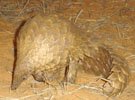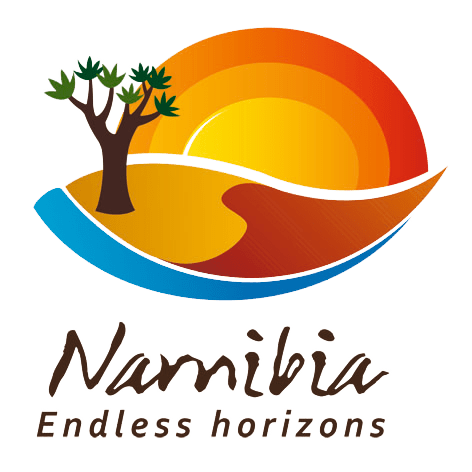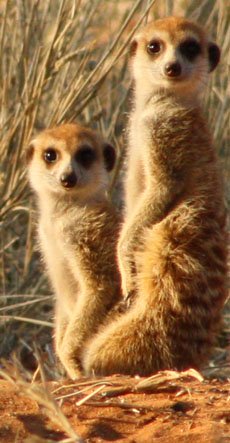For more information about our hunting safaris, don’t hesitate to reach out and contact us!
Trophy hunting
buoyant industry for Namibia
The enormous horns of the sable antelope suddenly appear out of the thick Namibian bush and the man with the rifle pulls the trigger. The animal goes down with a clean shot.
In keeping with tradition, the hunting guide plucks a small branch from a bush, dips it into the blood of the dead animal and hands it to a German tourist.
"Weidmann's Heil!" (Hunter's fortune) he says. "Weidmann's Dank," (Hunter's thank you), the hunter replies and fastens the branch to his hat.
"I love to come to Namibia to hunt because of the high standard of hunting ethics and the fact that I can also pick German-speaking professional hunting guides" says Dieter Weiler, who owns a small manufacturing plant near Berlin.
While killing wild animals for pleasure might be unacceptable in some parts of the world, Namibia has embraced a more pragmatic notion that a few can die for cash which helps fund the preservation of the rest of a herd.
Big bucks
Trophy-hunting brings in more than NAM$2-billion ($285-million, 210-million) per annum and has become a valuable part of Namibia's tourism industry.
Hunting is highly regulated and the 400+ members of Namibia Professional Hunting Association (Napha) adhere to a strict code of hunting ethics.
Read also...
Hunting clients, as they are called in Namibia, mainly come from the former colonial power Germany and the United States, but lately also from Eastern Europe. Some bring their own rifles, others bow and arrow.
"Game farming is gaining more importance in Namibia and many livestock farmers combine it with trophy hunting as the latter fetches better prices," says Ben Vermeulen, a farmer, who owns a farm some 120 kilometers southeast of the capital Windhoek.
"I am not a licensed professional hunter but I allow them to come to my farm with their hunting tourists and shoot carefully selected animals, earning extra in this way."
Auctions reflect the high value set on game species as a sale last Saturday at Okosongoro Safari Ranch, some 280 kilometers north-west of Windhoek showed.
Its owner, Peter Clausen has just completed construction of bomas (enclosures) to even hold giraffe, costing close to $2-million.
"Of the 270 animals for sale, we sold over 90 percent," Clausen told AFP after a two-hour auction attended by some 50 buyers.
"There are only two or three game auctions in the country each year in Namibia and some are live auctions where the animals were caught already and can be viewed in a boma like today. Others are just a catalogue auction, where a breeding group of say zebra, wildebeest or waterbuck are offered, but caught later," according to Clausen.
Fetching prices
The auction on Clausen's farm combined both systems and a sable antelope in the boma fetched $50 000, the two young giraffe together $9000.
A three-year old white rhino bull, born and bred on his Okosongoro ranch, fetched $120 000, another young bull and female $160 000.
Sylvia van Rensburg, who runs a tourism and hunting lodge in central Namibia with her husband, bought all three.
"We are happy with the price," she told AFP afterwards, "we attended a game auction in South Africa recently and one white rhino cost $300 000 too expensive."
The three rhinos will not be shot for trophy hunting, according to Van Rensburg. "They will roam freely on our lodge for photo safaris."
Auctioneer Clive Gardener, who flew in from South Africa for the weekend sale, says the quality of game in Namibia is outstanding.
Watch this video...
"The hunting industry in Namibia is buoyant and the condition of animals on auctions excellent," he said.
"The buyer is protected because the money for animals bought is paid into a fund. Should a bought animal die on transport, the buyer gets his money back with an interest rate."
A professional game catching company handles the animals and delivers them to the new owners within two months of an auction.
Wild game is also hunted in communal areas, earning rural people an income from tourism and sustainable trophy hunting in a country where 35 percent of the population are unemployed.
"So far 50 communal conservancies are registered covering a total area of 118 704km² or 14 percent of Namibia's total surface area, benefiting over 200 000 people" says Leon Jooste, deputy minister of environment and tourism.
"In many cases trophy hunting is the primary source of income for these often marginalised and remote communities.
"Trophy hunting, both as a commercial industry as well as a wildlife management tool, holds superior advantages for these communities, who often find themselves in direct competition with wildlife for the natural resources within their immediate areas."
Author: Brigitte Weidlich
More Namibia Hunting Info at...
Meaning of "Uitspan"
'Uitspan' is an Afrikaans word that means place of rest.
When the Boer settlers moved inland in Southern Africa in the 1800's, they used ox carts. When they found a spot with game, water and green grass, they arranged their ox carts into a circular laager for protection against wild animals and stopped for a rest.
They referred to such an action of relaxation for man and beast, as Uitspan.
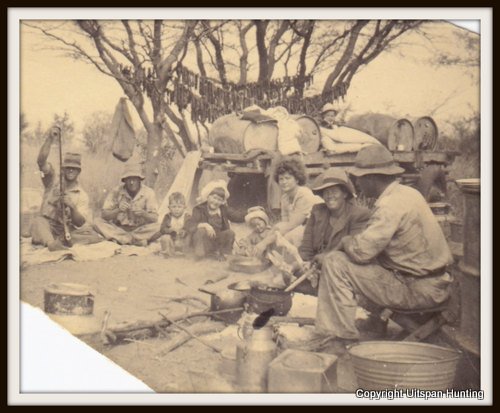
(Picture above of our ancestors.)
Did you know?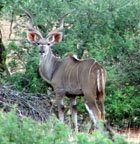 Greater Southern Kudus are famous for their ability to jump high fences. A 2 m (6.56 ft) fence is easily jumped while a 3 m (9.84 ft) high fence is jumped spontaneously. These strong jumpers are known to jump up to 3.5 m (11.48 ft) under stress. |
Did you know? Some animals have one sense more than man!The flehmen response is a particular type of curling of the upper lip in ungulates, felids and many other mammals. This action facilitates the transfer of pheromones and other scents into the vomeronasal organ, also called the Jacobson's Organ. Some animals have one sense more than man!The flehmen response is a particular type of curling of the upper lip in ungulates, felids and many other mammals. This action facilitates the transfer of pheromones and other scents into the vomeronasal organ, also called the Jacobson's Organ.This behavior allows animals to detect scents (for example from urine) of other members of their species or clues to the presence of prey. Flehming allows the animals to determine several factors, including the presence or absence of estrus, the physiological state of the animal, and how long ago the animal passed by. This particular response is recognizable in males when smelling the urine of a females in heat. |
